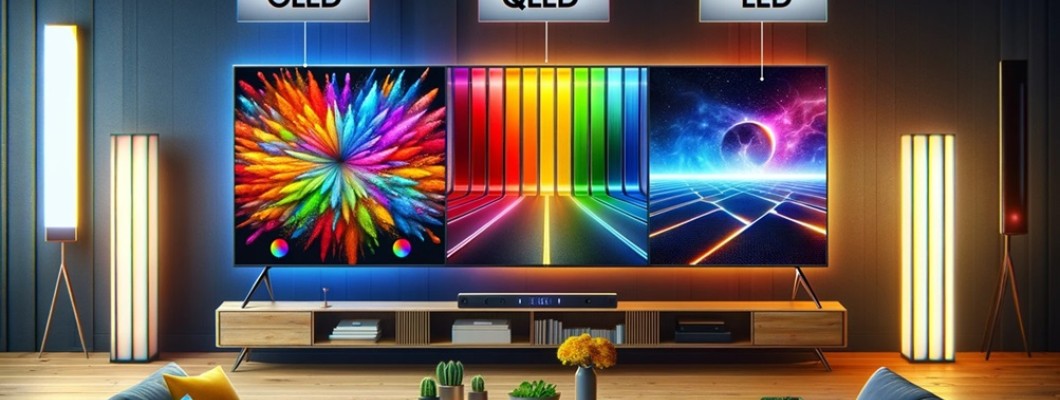
Choosing the right TV can be a daunting task, especially with so many options on the market. With advancements in technology, the decision has become even more complicated. Today, we're going to dive deep into the three most popular types of TV technology: OLED, QLED, and LED. By the end of this guide, you'll have a clear understanding of which technology is best suited for your needs.
Introduction to TV Technologies
Before we compare these technologies, let's break down what each one means.
OLED (Organic Light Emitting Diode): OLED TVs use a technology where each pixel emits its own light. This means that pixels can be turned on or off individually, allowing for perfect blacks and incredible contrast.
QLED (Quantum Dot Light Emitting Diode): QLED is a technology developed by Samsung. It uses a layer of quantum dots in conjunction with a traditional LED backlight. The quantum dots enhance the brightness and color accuracy of the TV.
LED (Light Emitting Diode): LED TVs are essentially LCD TVs that use LED backlighting. They are the most common type of TV on the market and come in a variety of configurations.
Now that we have a basic understanding, let's dive into the specifics of each technology.
Picture Quality
When it comes to picture quality, there are several factors to consider: contrast ratio, color accuracy, brightness, and viewing angles.
OLED:
- Contrast Ratio: OLED TVs are renowned for their exceptional contrast ratios. Since each pixel can be turned off completely, you get true blacks. This makes a significant difference in dark scenes.
- Color Accuracy: OLED TVs offer vibrant and accurate colors, with a wide color gamut that makes images pop.
- Brightness: While OLEDs have decent brightness levels, they may not be as bright as QLEDs, especially in well-lit rooms.
- Viewing Angles: OLEDs have superior viewing angles. You can watch from almost any angle without a loss in picture quality.
QLED:
- Contrast Ratio: QLEDs have improved contrast ratios compared to traditional LEDs, but they still rely on a backlight, which can cause some light bleeding.
- Color Accuracy: QLED TVs excel in color accuracy. The quantum dots enhance colors, making them vivid and lifelike.
- Brightness: QLEDs are known for their brightness. They can get exceptionally bright, making them ideal for bright rooms.
- Viewing Angles: QLEDs have improved viewing angles over LEDs but are not as good as OLEDs. Some quality may be lost at extreme angles.
LED:
- Contrast Ratio: LEDs generally have lower contrast ratios compared to OLEDs and QLEDs. This is due to the backlight, which can cause some blacks to appear grayish.
- Color Accuracy: While LEDs have decent color accuracy, they don't match the vibrancy of OLEDs or QLEDs.
- Brightness: LED TVs can get quite bright, making them suitable for well-lit environments.
- Viewing Angles: LEDs tend to have narrower viewing angles. Colors and contrast can shift when viewed from the side.
Durability and Lifespan
When investing in a TV, you want it to last. Let's look at the durability and lifespan of each technology.
OLED:
- Durability: OLEDs are more susceptible to burn-in, where static images can leave a permanent mark on the screen. However, modern OLEDs have features to mitigate this risk.
- Lifespan: The lifespan of an OLED TV is generally around 100,000 hours. This is more than sufficient for typical usage.
QLED:
- Durability: QLEDs are less prone to burn-in compared to OLEDs. This makes them a better option for users who watch a lot of static content like news channels or gaming.
- Lifespan: QLED TVs have a similar lifespan to OLEDs, often exceeding 100,000 hours.
LED:
- Durability: LEDs are quite durable and are less likely to suffer from burn-in.
- Lifespan: The lifespan of LED TVs is comparable to OLED and QLED, often reaching or exceeding 100,000 hours.
Cost
Price is always a major consideration. Let's break down the cost differences.
OLED:
- OLED TVs tend to be more expensive than their LED and QLED counterparts. The superior picture quality and technology come at a premium.
QLED:
- QLED TVs are generally priced between OLED and LED TVs. They offer excellent picture quality at a slightly lower price than OLEDs.
LED:
- LED TVs are typically the most affordable. They come in a wide range of prices, making them accessible for most budgets.
Energy Consumption
Energy efficiency is another important factor, especially if you're concerned about your electricity bill.
OLED:
- OLED TVs are quite energy-efficient because each pixel emits its own light. However, they can consume more power when displaying bright images.
QLED:
- QLED TVs are relatively energy-efficient but tend to consume more power than OLEDs, particularly at high brightness levels.
LED:
- LED TVs are the most energy-efficient among the three. They consume less power, making them a cost-effective option for long-term use.
Gaming Performance
For gamers, a TV's performance can make or break the experience. Let's look at how each technology fares in gaming.
OLED:
- Response Time: OLEDs have excellent response times, often less than 1ms. This means smoother gameplay with minimal motion blur.
- Input Lag: OLEDs generally have low input lag, making them great for fast-paced games.
- HDR Performance: The high contrast ratio and color accuracy make OLEDs ideal for HDR gaming.
QLED:
- Response Time: QLEDs have good response times, though not as fast as OLEDs.
- Input Lag: QLEDs also have low input lag, suitable for most gaming needs.
- HDR Performance: QLEDs offer excellent HDR performance due to their brightness and color accuracy.
LED:
- Response Time: LED TVs have decent response times but may suffer from more motion blur compared to OLEDs and QLEDs.
- Input Lag: Modern LED TVs have low input lag, but it can vary by model.
- HDR Performance: While LEDs support HDR, they may not perform as well as OLEDs and QLEDs in this area.
Environmental Impact
The environmental impact of your TV choice is worth considering.
OLED:
- OLED TVs use organic materials, which can be more environmentally friendly. However, they are harder to recycle due to their complex construction.
QLED:
- QLED TVs use quantum dots, which are inorganic. This makes them less environmentally friendly compared to OLEDs.
LED:
- LED TVs are relatively easy to recycle and have a lower environmental impact compared to OLEDs and QLEDs.
User Experience
User experience encompasses ease of use, smart features, and overall satisfaction.
OLED:
- Ease of Use: OLED TVs are generally user-friendly with intuitive interfaces.
- Smart Features: Most OLEDs come with advanced smart features, voice control, and a wide range of apps.
- Overall Satisfaction: Users often rave about the picture quality and viewing experience.
QLED:
- Ease of Use: QLED TVs also have user-friendly interfaces and are easy to set up.
- Smart Features: They come packed with smart features, similar to OLEDs.
- Overall Satisfaction: QLED owners appreciate the bright, vivid pictures and robust build quality.
LED:
- Ease of Use: LED TVs are straightforward and easy to use, though smart features can vary widely.
- Smart Features: Many modern LED TVs have smart capabilities, but they may not be as advanced as OLEDs or QLEDs.
- Overall Satisfaction: LED TV users value the affordability and decent performance.
Conclusion: Which TV is Right for You?
Choosing between OLED, QLED, and LED ultimately depends on your specific needs and preferences.
Choose OLED if:
- You want the best possible picture quality with perfect blacks and vibrant colors.
- You have a controlled viewing environment (like a home theater) where you can appreciate the contrast.
- You’re a gamer or movie enthusiast looking for top-tier performance.
Choose QLED if:
- You need a bright TV for a well-lit room.
- You’re looking for excellent color accuracy and don’t mind a slightly higher price tag.
- You want a durable TV that’s less prone to burn-in.
Choose LED if:
- You’re on a budget and need a reliable TV with decent performance.
- You want an energy-efficient option that’s also environmentally friendly.
- You don’t require the absolute best picture quality and are okay with some trade-offs.
Each technology has its strengths and weaknesses. By understanding these differences, you can make an informed decision that fits your lifestyle and viewing habits. Happy TV shopping!

Leave a Comment